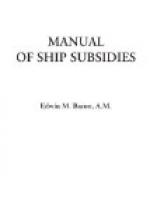The other influences contributing to this extraordinary growth are variously stated according to the observer’s point of view. The United States consul at Hamburg sees them in the “rapid transformation of the country from a non-producing nation into one of the foremost industrial powers of Europe, a large available supply of excellent and cheap labor, and the geographical situation of the empire."[CX] The historian of Modern Germany sees them in German business methods:
“The astonishing success of the German shipbuilding industry is due partly to its excellent management and organization; partly to the application of science and experience to industry; * * * partly to the harmonious co-ordination and co-operation of the various economic factors which in more individualistic countries, such as Great Britain, are not co-ordinated, and often serve rather to obstruct and to retard progress by unnecessary friction than to provide it by harmonious action."[CY]
FOOTNOTES:
[Footnote CJ: For this Memorial see U.S. Con. Rept., no. 112, Jan., 1890, pp. 108-118.]
[Footnote CK: J. Ellis Barker, “Modern Germany,” 3rd edition, 1909.]
[Footnote CL: Wells, p. 166.]
[Footnote CM: U.S. Con. Rept., no. 61, 1886, pp. 285-287.]
[Footnote CN: Barker, 3rd ed.]
[Footnote CO: Meeker.]
[Footnote CP: U.S. Con. Repts., 1889, no. 101, p. 544.]
[Footnote CQ: Meeker. Also German report on the operation of the law of 1885, in report of (U.S.) commissioner of navigation for 1898.]
[Footnote CR: Meeker. Also German report on the operating of the law of 1885, in report of commission of navigation for 1898.]
[Footnote CS: Barker, 3rd ed.]
[Footnote CT: Meeker.]
[Footnote CU: Barker, 3rd ed.]
[Footnote CV: U.S. Con. Rept, no. 13, July, 1906, pp. 87-89.]
[Footnote CW: Lloyd’s Register, 1910-11.]
[Footnote CX: U.S. Consul General Robert P. Skinner, Hamburg, in Daily Con. Repts., April 8, 1911, no. 82.]
[Footnote CY: Barker, Modern Germany, p. 490.]
CHAPTER V
HOLLAND—BELGIUM
The home Government of the Netherlands gives neither construction nor navigation bounties. Only subventions to steamship lines for carrying the mails are granted. The single purpose of these subventions is declared to be to secure the prompt and effective furtherance of the mails at reasonable cost.[CZ] The contracts are not publicly let, but go to the several steamship lines plying to foreign ports and to the Dutch colonies. The amounts fixed by contract are at a given rate per voyage. The cost of the subventions to the Dutch East Indian lines is divided equally between the home and colonial Governments. Independently of the home Government the Dutch East Indian Government grants general mileage subventions for the maintenance of lines making regular communication with the various ports of the East Indies.[CZ] Holland’s gross tonnage in 1910 had reached the respectable total of 1,015,193 tons,[DA] ranking her eighth among the maritime nations.




